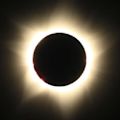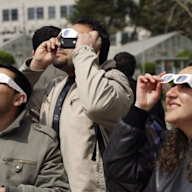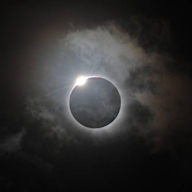Search results
On April 8, 2024, a total solar eclipse moved across North America, passing over Mexico, the United States, and Canada. A total solar eclipse happens when the Moon passes between the Sun and Earth, completely blocking the face of the Sun. The sky will darken as if it were dawn or dusk.
To see it full screen, visit go.nasa.gov/EclipseExplorer. NASA's Scientific Visualization Studio. The Monday, April 8, 2024, total solar eclipse crossed North America, passing over Mexico, the United States, and Canada. The total solar eclipse began over the South Pacific Ocean.
- Only Visible Along A Narrow Path
- Not Total Everywhere
- Complete Solar Eclipse Has Five Phases
- Protect Your Eyes!
- Only Safe During Full Eclipse
- Unique Sights Around Totality
- The Science of Total Solar Eclipses
- How Long Does Totality Last?
Every 18 months or so—somewhere in the world—a total solar eclipsetakes place. The total phase of the eclipse, where the Moon completely covers the Sun, is visible from along a narrow path of totality. Typically, this path across the globe is around 15,000 km (9000 miles) long, but only about 150 km (90 miles) wide. Which cities get the most eclips...
Observers outside the path of totality may see a partial eclipse. By convention, eclipses are named after their darkest phase—if a solar eclipse is total at any point on Earth, it is called a total solar eclipse. Hybrid solar eclipses or annular-total eclipses are an exception to this rule. This is because they change from an annular to a total ecl...
What can you see during a total solar eclipse? There are five stages in a total solar eclipse: 1. Partial eclipse begins(1st contact): The Moon becomes visible over the Sun's disk. It looks like the Moon has taken a bite out of the Sun. 2. Total eclipse begins (2nd contact): The Moon covers the entire disk of the Sun, and observers are now within t...
Never look directly at the Sun, eclipsed or otherwise, without proper protective eyewear. The Sun’s radiation can burn your eye's retinas and cause permanent damage or even blindness. To safely watch a solar eclipse, wear protective eclipse glasses or project an image of the eclipsed Sun using a pinhole projector.
It is safe to view a fully eclipsed Sun, totality, with the naked eye. It is also safe to observe totality through cameras, telescopes, or binoculars without any special filters. Do not look at the Sun with naked eyes unless the Moon blocks the entire Sun. Even a small amount of direct sunlight can damage your eyes. Make sure you know how long tota...
Some sights are only visible during a total solar eclipse. They appear in this order as totality sets in (and in reverse order as totality ends): 1. Shadow bands: About a minute before totality, moving, wavy lines of alternating light and dark can be seen on the ground and along walls. These shadow bands are the result of Earth’s turbulent atmosphe...
On average, one total solar eclipse happens every 18 months, when: 1. There's a New Moon, 2. at the same time, the Moon is at (or very near) a lunar node, so the Earth, the Moon, and the Sun line up in a straight (or nearly straight) line, 3. and the Moon is near perigee. Eclipse Shadows: Umbra, Penumbra, and Antumbra
A total solar eclipse can last for several hours and totality can range from a few seconds to 7.5 minutes. The longest total solar eclipse of the 21st century took place on July 22, 2009, when totality lasted 6 minutes and 39 seconds! Topics: Astronomy, Eclipses, Moon, Sun
Apr 8, 2024 · What is a total solar eclipse? A solar eclipse occurs when the moon orients itself between Earth and the sun, shielding the solar surface from our view. In cosmic...
- Katrina Miller
- 2 min
Apr 8, 2024 · A total solar eclipse — nicknamed the Great North American Eclipse for its long path over North America — was visible in the sky today over parts of Mexico, 15 U.S. states and eastern Canada....
Apr 8, 2024 · Make a Sun projector a pair of binoculars or a telescope to safely watch solar eclipses or a planet transit. Interactive map showing where the total solar eclipse of April 8, 2024 is visible—with local times and average cloud cover for any location.
Apr 8, 2024 · A total solar eclipse won’t be visible again from the contiguous US until August 22, 2044, but totality will only occur over North Dakota and Montana, plus northern Canada.
People also ask
What is a total solar eclipse?
When is the next total solar eclipse?
How long is a total eclipse?
What happens during a total solar eclipse?






